Every now and then it’s good to loosen up and try something different. Here are some recent sketchbook pieces with gouache, coloured pencil, charcoal and some collage.
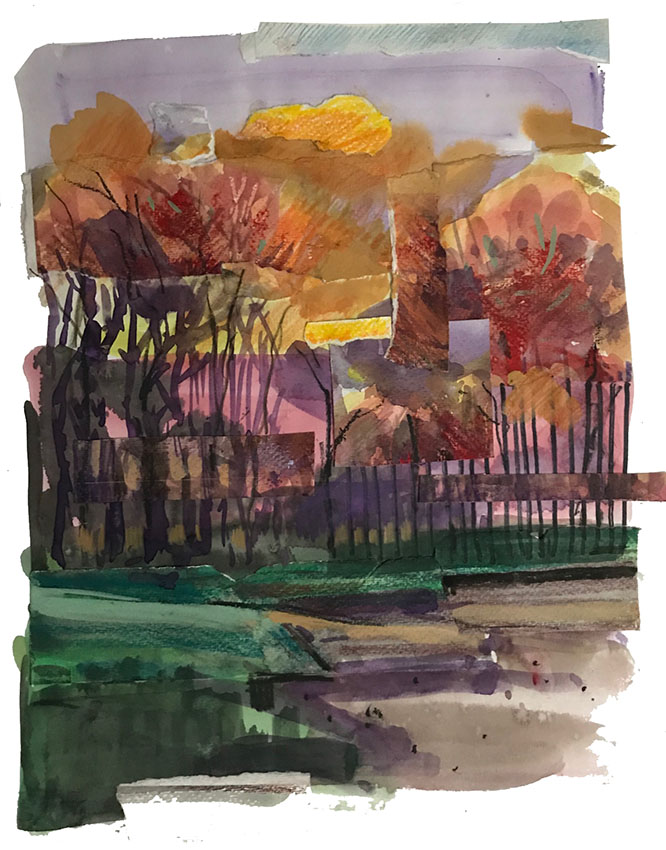
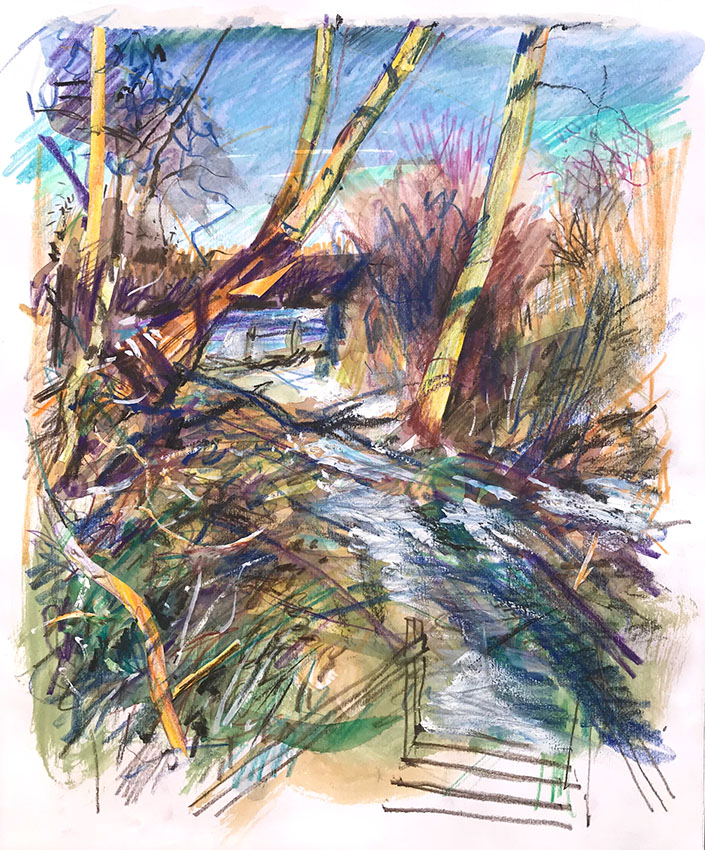
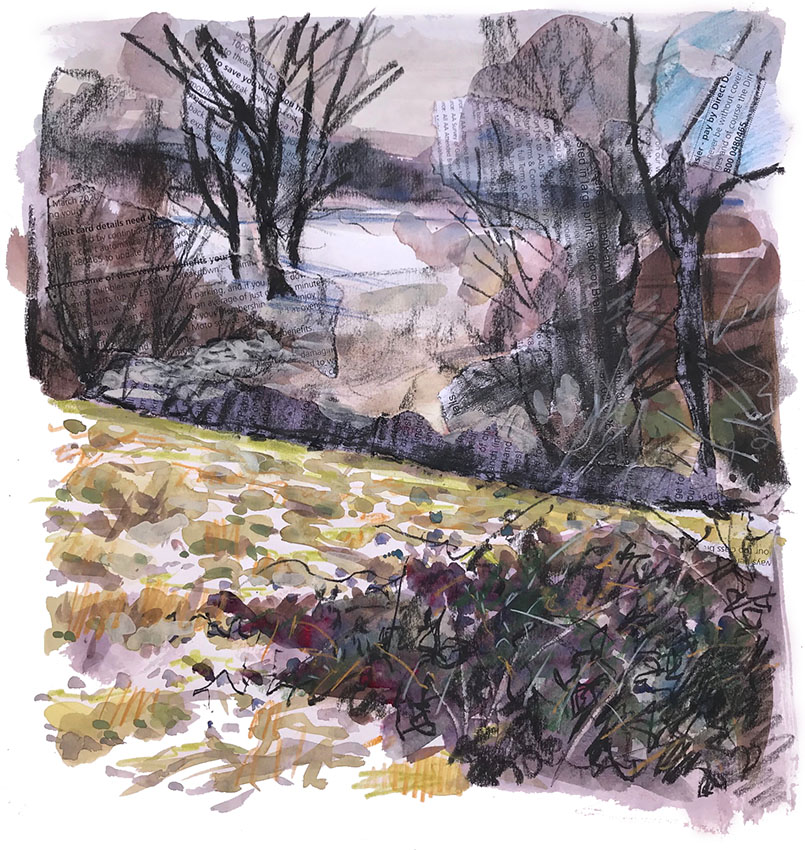
Every now and then it’s good to loosen up and try something different. Here are some recent sketchbook pieces with gouache, coloured pencil, charcoal and some collage.



A rainy morning but just enough time for a quick oil study of a country footpath in Hertfordshire, UK.

A couple of days later, I returned with a larger canvas to paint another view of the same footpath. This needed two sessions, a couple of days apart, and a few tweaks in the studio to complete.
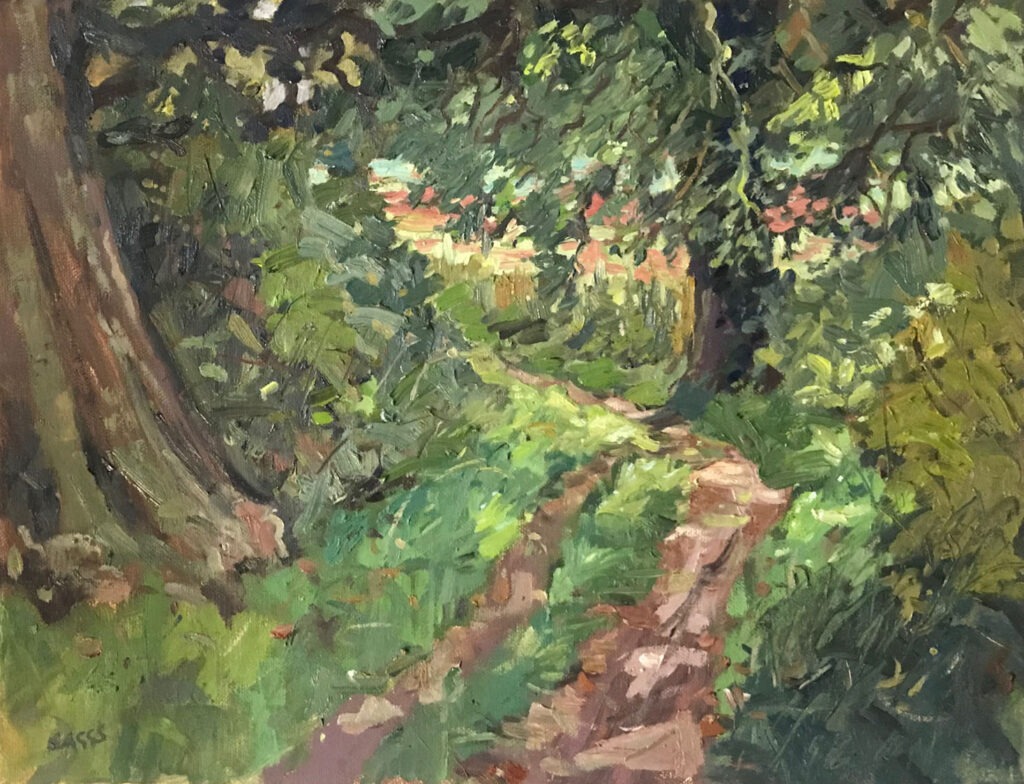
Marden Hill, Hertfordshire
Marden Hill, between Welwyn Garden City and Hertford. An area of largely unused paddocks and meadows popular with dog walkers and the occasional birder. Overhead, Red kites are now common, and Ravens soaring in pairs is no longer a rare site, as in much of lowland Britain. I was fortunate to disturb a Redstart on autumn migration in the low, berry laden brambles that cluster around some remaining fence posts. Nuthatches quip in the high beech trees and oaks that sit on the high ridge, exposed to the wind.
Still very warm in September, the exposed trees on the edge of the wood drew my attention. Several trees had fallen, leaving a gap that threw those that remained into relief against the sky. They seemed to stand defiantly at angles competing with each other, rocking in the breeze.
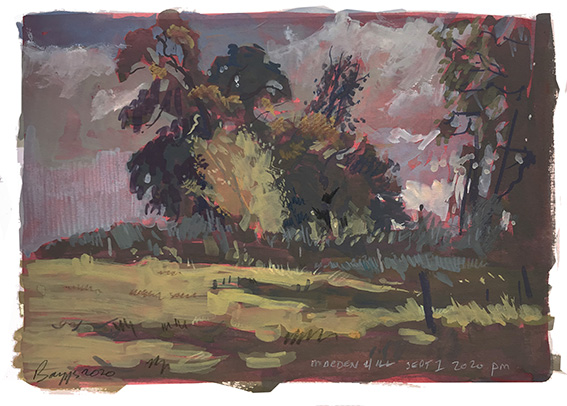
I made this quick sketch in gouache and coloured pencil on a red ground, aiming to record the late summer afternoon mood.

Going back several times to the same spot, producing a pencil sketch and then painting in oil on card (old backs of drawing pads, primed with acrylic, can be very useful when you are fresh out of ‘proper’ canvases or panels).
The afternoon sun streamed through the wood, catching the top of the young tree in front of the tall, swaying beeches.
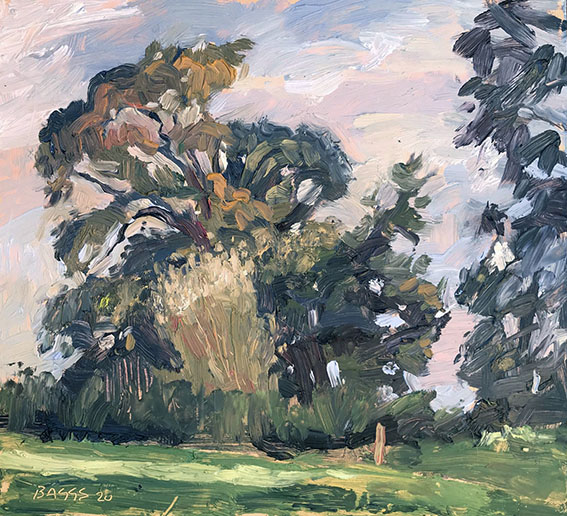
I like to visit the same location in different weather conditions, time of day and even seasons, to get to know it well – picking out likely spots to paint or draw. This area, with its scattered mature trees planted with intent many years ago, now has the look of a forgotten landscaped park.
There will be more to be had here.

It’s mid-summer. The early morning sun lights up the long grass and all is a grey orange, hard to describe but wonderful to look at.
In the field beyond my weed filled ditch is a rotation crop full of blue flower. There seems to be a bee every square metre, and there is a gentle hum.
Over the next couple of days I try and capture my response to this on a small 8 x 10 canvas. It takes several sessions of about half an hour each, and stopped when it all ‘felt right’.
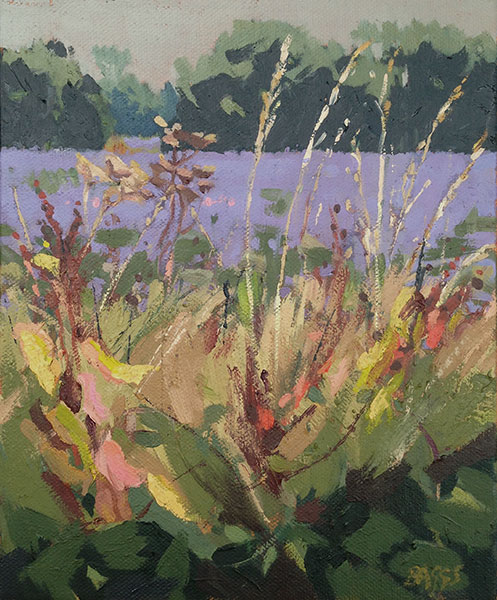
I went further with the theme but with a completely different approach,
and created a paper collage of the same scene in the studio.
This time I included one of the butterflies that passed by regularly as I stood there.
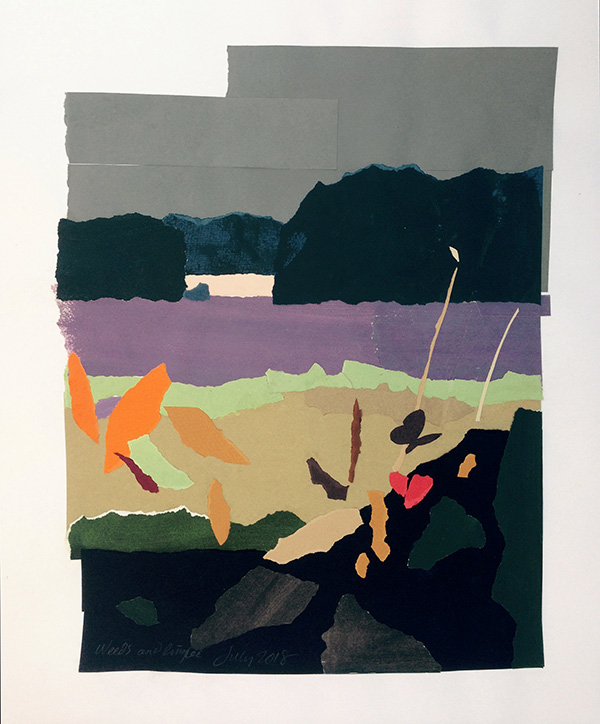
It’s early summer, the weather is good, time for a warm up painting or three before I sling all the gear in the car and try my hand at a few en plain air landscapes. Looking around in the garden for potential subjects I noticed a red chair and big yellow plastic bin calling attention to themselves under a fruit tree that sails across at an angle, on which I’d hung a basket of lobelia. There’s a nice balance where the viewer’s attention is kept by the colours and angles, with the shadow of the tree taking you back around. I moved things around slightly here and there until I was satisfied with the placement of the objects, and then started to loosely sketch onto an 8 x 10 inch canvas. It was then that I noticed the patch of long grass and nettles behind was a bit bland, so I placed an aluminium pot there to ‘fill the void’.
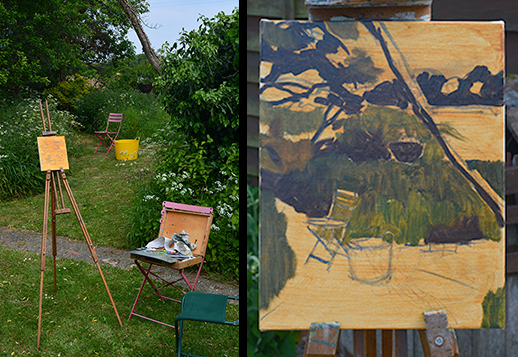
I usually cover canvases with a thin layer of raw sienna to avoid painting on white. After a simple pencil line I go over this in very thin ultramarine to roughly indicate the main spaces, and then thinly block in the dark areas. I’m also using my oldest and much loved wooden sketching easel which I’ve repaired a few times. It’s not too stable out in the open in even a slight wind, but you make do. Hanging a heavy kit bag on it helps a lot.
I’m also using a very limited palette of just two blues (ultramarine and cobalt), two yellows (lemon yellow and yellow ochre) and two reds (light red and cadmium red) plus white. I can mix everything I’ll need from these, even using the white sparingly. It’s good discipline too, and will help me avoid using too many unnecessary colours. I prefer turpentine to any other medium, not just because I just love the smell!

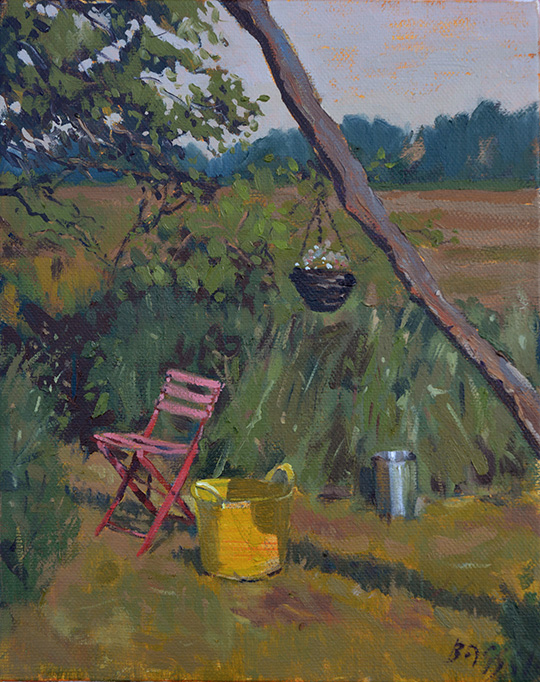
As I was working just outside my own back door, I took my time and completed the picture in six sessions of about half hour each, over a couple of weeks. Partly because the shadows had to be in the right place and therefore the sun had to be shining! I spent nearly as much time looking and assessing and making decisions about what comes next or what to change as I did actually painting. This is normal for me, it’s an all consuming experience. I was careful to describe the aluminium pot in just a stroke or two, and the yellow bin didn’t need much work at all, you can see the stain of the raw sienna on the canvas easily. The only area I’m not too sure about is the patch of nettles but overall the finished painting is ok. On to the next one….
The flash of yellowish green, black, and a bit of red as you disturb a Green Woodpecker up ahead, flying directly away from you in that classic, undulating flapping flight. Probing for ants, a favourite food, this one was on my front lawn, seen from indoors. The bill is remarkably large and dagger-like, and if I was an ant, I might feel quite intimidated.
I was aiming to capture, from an ant’s eye view, that intense look in the woodpecker’s eye as it concentrates on what can be had below.
The finished image continues the paper collage series.
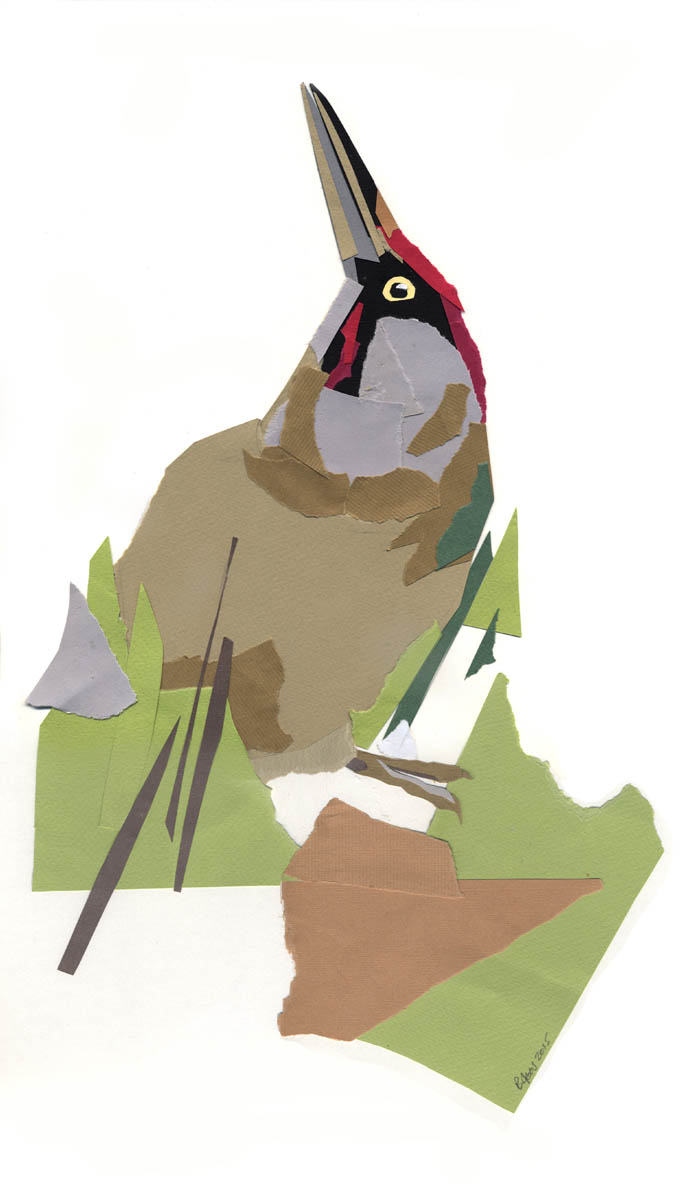
Misty distant woods and field margins. Hares, pheasants and deer tracks.
The sound of running water, the ‘good earth’ aroma of autumn leaves.
As I wait for my washes to dry enough to carry on, it starts to rain.
Fine, soft rain, but enough to force me to abandon this painting.
The four hares in the field remain undisturbed.
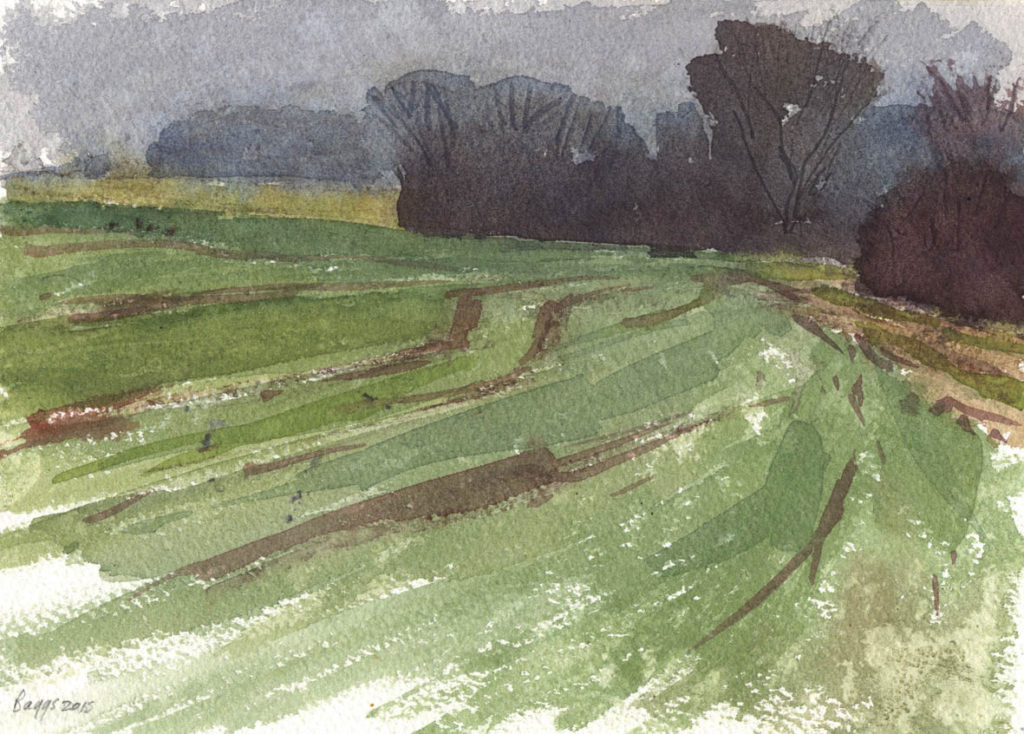
Here are two common summer visitors to the UK. Common Whitethroats and Blackcaps are closely related, Blackcaps prefer woods and thicker cover, while Whitethroats prefer more open habitat such as hedgerows and scrub. There is a good deal of overlap, and I see both on my walks around and about here.
Both birds are not shy, Whitethroats seem to scold a passer by with their ‘char’ call, and often momentarily pop up from their cover to check you out. Blackcaps like to sing loud and proud from higher up in the trees, and again, will sometimes stop and give you the eye before continuing.
It was this inquisitive and no nonsense attitude I was aiming to capture. The simplicity of using torn and cut paper helps in illustrating their character and expressions, and as the view through binoculars is seldom perfect, with seemingly random free floating foliage covering most of the bird, (sometimes all of it!) I was keen to show that also.


Here are some line drawings from my sketchbook where I’m using a sepia coloured felt-tip pen to draw the scene. Quite a slow, deliberate process compared to my usual freer pencil drawings, and with a couple of these I found it useful to add some watercolour to ‘key in’
some of the spaces.
This first spread shows two drawings of a country road not far from home. I was interested in a graphic, linear shorthand to describe forms and textures. No need for a colour wash here.
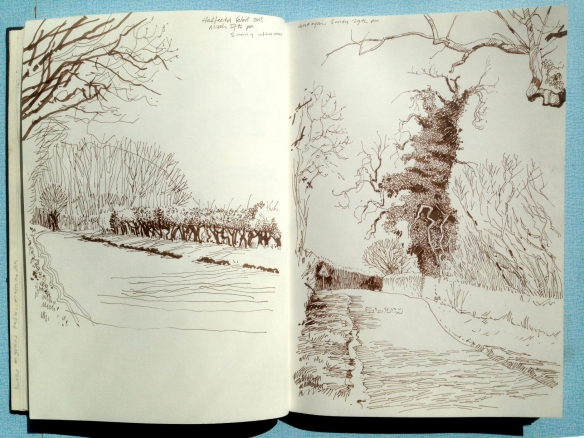
Cat’s Hill Lane, Ludwell.
I spent the Easter break with family in Dorset. I’ve driven past this winding lane countless times over the years and only now decided to stop and draw it. The couple walking their dogs came from behind me and strolled down the lane. I waited until they reached the shed before sketching them in. I added some colour to the verges and meadows, including the far field where the cows are grazing.
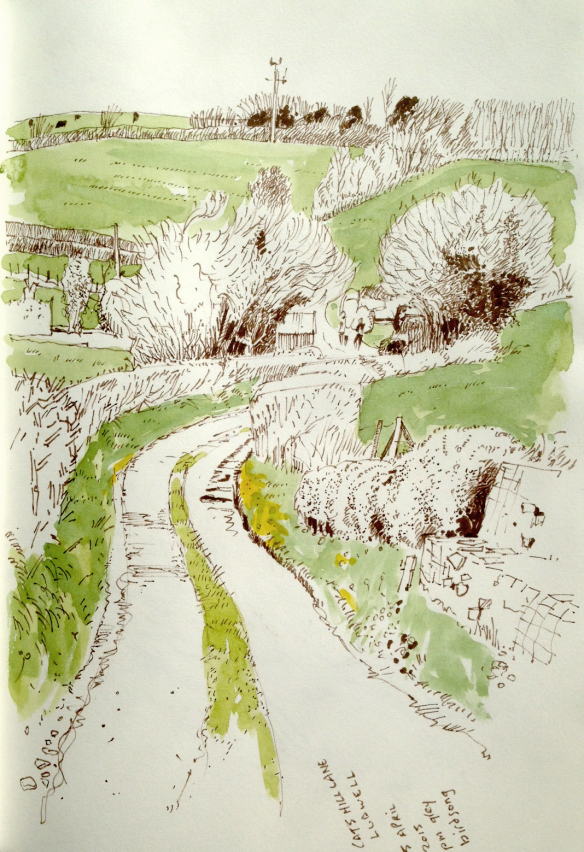
This drawing is of a small stream winding its way through a copse in the spring sunshine. The bottom of the stream here is muddy but in other places it is stony and moderately fast flowing. In many places the water is only two inches deep, but there are some deeper pools where small fish find a decent living. I edited out quite a lot of ‘tree bits’ and settled for just enough to describe the overall look of the spot.

At the end of this small copse, the stream emerges and cuts across the green lane before
falling through the roots of a tree in a mini, noisy waterfall and creating a deepish pool, before continuing on through the hedgerow. I got the watercolours out for this one.
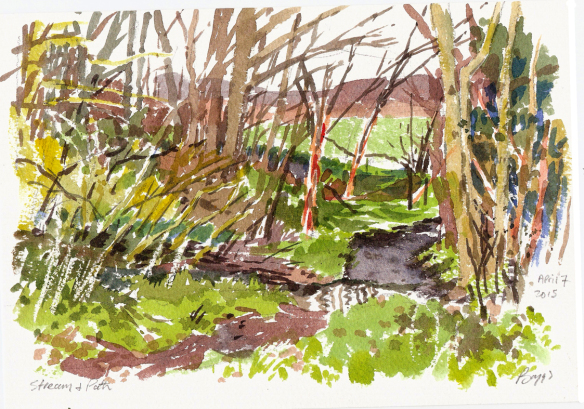
This image is a slight departure as I’ve used cut and torn paper to tell the story and simplify things. It’s the moment when you are confronted by the unexpected. On a late afternoon visit to the rough field behind the cottage this barn owl and me surprised each other around the headland shrubbery. I was aiming at capturing the suddenness of it all.
The paper is nearly all Ingres pastel paper with a piece of old oil painting block, now
too brittle to paint on. Although the landscape is described with torn paper, there were
still some decisions to make with placing and colours. I cut out a dummy owl from
plain white paper to position it until it felt right. Cutting the bird off the edge of the frame is crucial, as is the angle, it gives the sense of surprise and urgency I was after. In the event, the bird was quite indignant, and performed a mini hover and let out a harsh squawk, before flying off in the opposite direction!